Premium
Pomp and colour as Ruto, Gachagua grace MPs wa Mumbi and Betty dowry ceremony

President Willam Ruto (left), Deputy President Rigathi Gachagua (right) and MPs Eric Wamumbi (MP Mathira) and Betty Maina (Woman Rep Muranga) during Ms Maina and wa Mumbi's dowry negotiations function in Murang'a County on November 18, 2023.
What you need to know:
- Gachagua acted as wa Mumbi's chief spokesperson whose role was to steer the negotiations.
- Ndindi Nyoro was the chief agent in the process of handing over Ms Maina to Mr Wa Mumbi.
President William Ruto and his Deputy Rigathi Gachagua were among the dignitaries that graced dowry negotiations for Mathira MP Eric wa Mumbi as he seals nuptials with Murang'a woman Rep Betty Maina.
Kiharu MP Ndindi Nyoro who had in April been appointed Ms Maina's lead negotiator in trying to milk as much benefits possible from wa Mumbi's delegation.
President Ruto arrived in a chopper from his official duty in Kirinyaga County where he also addressed public rallies.
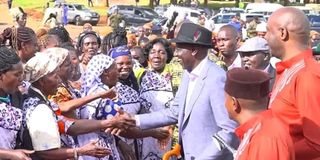
President William Ruto attends the dowry payment ceremony for Mathira MP Eric wa Mumbi and Murang'a woman Rep Betty Maina on Saturday, November 18.
The lively event becomes the most prominent dowry negotiations event to be attended by a sitting president and a sitting deputy president in Murang'a County.
After Wa Mumbi visited Betty's parents in April to officially announce he was living with their daughter, he now moves closer to sealing the nuptials as per Agíkúyú community traditions.
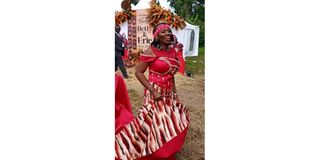
Betty Maina runs to Eric wa Mumbi during their dowry negotiations function in Murang'a County on November 18, 2023.
Also Read: I will marry when I want, MP says
In April, he delivered to Ms Maina's parents in Kangari Village of Murang’a County an ewe (Mwatí) and a he goat (harika) as a declaration that he (he goat) and she (ewe) were having intentions of tying the knot.
The animals are delivered live and are not computed into cash.
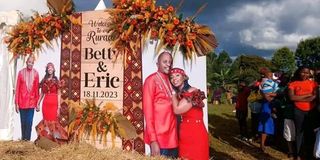
Betty Maina and Eric wa Mumbi dowry negotiations function in Murang'a County on November 18, 2023.
Present to witness the ceremony that is known as Kúhanda ithígí were governors Anne Waiguru (Kirinyaga), Irungu Kang’ata (Murang’a) and Nyeri’s Mutahi Kahiga. Others present were senators including Nyutu (Murang'a) and Wahome wa Matinga (Nyeri).
Also present were MPs led by Kiharu’s Ndindi Nyoro who had in April been appointed Ms Maina's lead negotiator in trying to milk as much benefits possible from wa Mumbi's delegation, National Assembly majority chief whip Silvanus Osoro, Embakasi East MP Babu Owino and Maragua MP Mary Wa Maua.
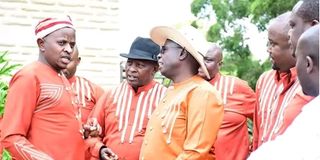
Deputy President (in Panama hat) consults with Mathira MP Eric wa Mumbi (left) as other elders from Nyeri follow as they prepared to face Murang'a elders in dowry payment negotiations for Murang'a woman rep Betty Maina on Saturday, November 18.
Mr Wa Mumbi then proceeded to plant a tree branch (ithígí) to signify that Ms Maina is effectively ‘off the market’.
Also Read: Irungu Kang’ata finally weds
So serious and final is the Kúhanda ithígí ceremony that the couple are free to live together even before the dowry payment, though the two have since confessed that they moved in together in 2022 as they campaigned for their respective seats.
After the Saturday's event Betty now remains with wa Mumbi and as long as it lasts, no other man, for now, can initiate a process of marrying her.
"Unless the courtship is broken through rituals and Ms Maina's clan cleared to abolish the initiation of the now recognized in-law bond, or, Wa Mumbi departs from the world, she is now out of bounds," said Mzee Javan Murage 86.
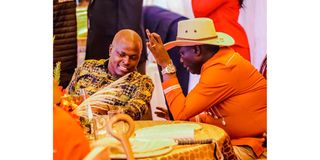
Kiharu MP Ndindi Nyoro (left) with Deputy President Rigathi Gachagua during MPs Betty Maina and Eric wa Mumbi dowry negotiations function in Murang'a County on November 18, 2023.
Mr Gachagua acted as wa Mumbi's chief spokesperson whose role was to steer the negotiations.
The bride’s close friends, sisters and female cousins escorted her to the function.
The symbolic activity in the dowry payment saw Mr Wa Mumbi paying dowry (kúracia) as was negotiated and his people delivering two fattened rams (Ngoima) and other gifts.
In the Agíkúyú community, the bride's father (guardian) is not allowed to charge more than he paid for his wife as dowry, though modern sophistication and classy inclinations have completely eclipsed such considerations.
The dowry price is valued in terms of goats, honey and traditional brew.
It’s only after the final price (kunírwo mítí) is determined that the agreed value is converted into cash.
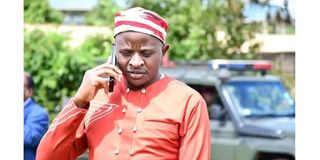
Eric wa Mumbi's 'call to love gods' as he prepares to face off with Murang'a elders in his dowry negotiations for Murang'a Woman Rep Betty Maina.
However, the bridal price is considered as just part of a long-term bond, reason why there is no demand that it be paid in full. It is set at 100 goats but recorded as 99 to signify the minus one as long-term bond that makes the two in-laws enjoy permanency of bond.
After dowry is paid, the bride’s parents will visit the groom’s house in a ceremony called kuona itara (visiting the nest).
The bride’s mother escorts her and officially hands her over to her mother-in-law who embraces and welcomes her by giving her a tour of the home.
Also Read: Joy and laughter as MP, 45 finally weds
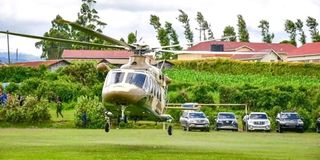
Some State witnesses during MPs Eric wa Mumbi and Betty Maina dowry negotiations descended from the skies.
Wa Mumbi will later be expected to undertake another ceremony called Ngurario or gútinia kíande which is the crux of the customary wedding ceremony.
In the ceremony, the groom feeds the bride with the softest part of the front limb of roasted ram.
The softness is a symbol of warmth and affection, the single joint in the front limb symbolizing permanency of the union and the limb itself signifying support and a shoulder to lean on in the marital life.
The couple also feed each other pieces of goat ears (kúría matú) to announce dialogue as the key component in that marriage.
It is only after these processes are exhausted that the two can tie their nuptials in church.
However, nowadays rivalry between traditions and religion have disorganized the processes and it is upon individual family to find where the two converge in founding nuptials.





